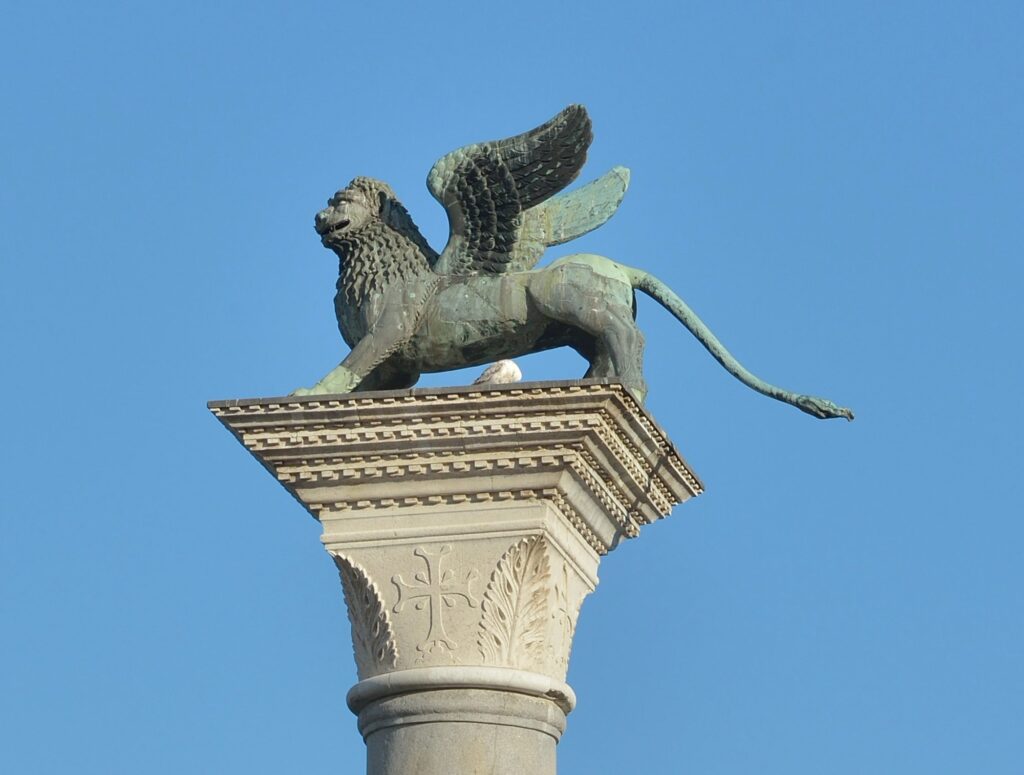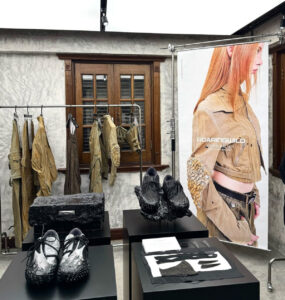The iconic “Lion of Venice” is perhaps one of the most recognizable symbols in Italy. Perched atop a column in Piazza San Marco, the winged lion has long been a symbol of the Republic of Venice, representing its power, wisdom, and dominance over land and sea. However, recent studies have challenged the long-held assumption that this majestic bronze sculpture was crafted locally or even within Europe. Groundbreaking research suggests that the famous lion may, in fact, originate from the distant Yangtze River basin in China, making it one of the most intriguing cross-cultural artifacts in history. This new study posits that the lion, once believed to be Venetian in origin, may have been a colossal tomb guardian reassembled in its current form after being brought to Italy.
A Closer Look at the Lion of Venice
The winged Lion of Venice has been sitting atop its column since at least the 12th century, and over the centuries, it has undergone several restorations. Though it now stands proudly with its wings spread, it hasn’t always looked the way we see it today. Detailed inspections have revealed that the lion is a patchwork of different metal pieces, raising questions about its original appearance and the methods used to assemble it.
It was initially believed that the lion was crafted by local artisans, drawing inspiration from biblical and mythological traditions where winged lions symbolized evangelists, specifically Saint Mark, Venice’s patron saint. However, some experts have long noted the lion’s unusual features, which distinguish it from other European lion depictions of the period. The structure, proportions, and certain stylistic elements of the statue have led many to question its true origins.
The Discovery: Tracing the Lion’s Origins to China
The theory that the Lion of Venice might not be Italian or even European in origin has gained momentum thanks to recent scientific research. A team of art historians, archaeologists, and metallurgists conducted an extensive study of the lion, examining its metal composition and stylistic features. Using advanced dating techniques, they were able to trace the lion’s metalwork to regions in East Asia, specifically along the Yangtze River basin in China.
The research suggests that the lion may have originally been a tomb guardian or part of a funerary complex. In ancient China, particularly during the Han Dynasty (206 BC–220 AD), it was common to use stone or metal sculptures of mythical creatures to guard tombs and protect the dead in the afterlife. These tomb guardians, known as “zhenmushou” in Chinese, often depicted lions, tigers, and other fantastical beasts, some with wings or other hybrid features. The presence of wings on the Lion of Venice aligns with this tradition, suggesting that it could have originally served as a zhenmushou in China before being transported to Europe.
A Journey Across Continents: How Did the Lion Get to Venice?
If the Lion of Venice is indeed Chinese, the question arises: how did such a large and significant sculpture make its way from the Yangtze River basin to the canals of Venice? To answer this, we must look at Venice’s historical role as a major trading hub between East and West. During the height of the Venetian Republic, Venice controlled vast trade networks that extended as far as China. Venetian merchants were instrumental in transporting goods like silk, porcelain, and spices from the East to Europe, and it’s not inconceivable that artworks and cultural artifacts made the journey as well.
Some scholars speculate that the lion could have been brought to Venice as part of the lucrative trade exchanges during the Middle Ages. During this period, Venetian traders had extensive contact with the Mongol Empire, which, at its height, stretched from China to Europe. Through these trade routes, known as the Silk Road, objects of great value and cultural significance often found their way from East Asia to European cities. The lion may have been one such object, brought to Venice either as a diplomatic gift or a rare artifact for the city’s ruling elite.
Reassembly: The Lion’s Transformation in Venice
One of the most fascinating aspects of the Lion of Venice is the fact that it appears to have been reassembled after arriving in Italy. The sculpture is composed of different pieces that, upon closer inspection, do not all seem to fit together perfectly. This has led researchers to hypothesize that the lion was originally a larger, more complex statue or collection of statues that were dismantled and shipped in parts before being reassembled in Venice.
Further supporting this theory is the fact that several of the lion’s features, such as the wings, seem to have been later additions. These additions may have been made to align the sculpture with the traditional Christian symbol of Saint Mark’s winged lion, which is a common representation in Venetian iconography. The reassembly of the lion could have involved adapting the original Chinese sculpture to fit the cultural and religious context of Venice at the time.
This practice of reworking and repurposing imported artifacts was not uncommon in the Middle Ages. European artisans often modified objects from distant cultures to suit local tastes or align with specific religious or political narratives. In the case of the Lion of Venice, it is likely that local craftsmen adapted the original Chinese tomb guardian, adding wings and other elements to create a statue that would serve as both a symbol of Venice and a tribute to Saint Mark.
Impression
The Lion of Venice has long been more than just a statue; it is a potent symbol of the city’s identity, representing its power, strength, and connection to Saint Mark. The lion is a recurring figure in Venetian art and architecture, appearing on flags, coins, and monuments throughout the city. Its association with Saint Mark, whose relics were supposedly smuggled to Venice from Alexandria in 828 AD, cemented its place as the city’s most revered emblem.
If the lion’s Chinese origin is confirmed, it adds a fascinating layer of complexity to its symbolic meaning. While the lion has always been seen as a representation of Venice’s authority, its Asian origin would suggest that Venice’s identity was shaped, at least in part, by its connections to distant cultures. The idea that Venice—a city famed for its cosmopolitanism and its role as a bridge between East and West—would adopt and repurpose a Chinese tomb guardian as a symbol of its own power is a testament to the city’s ability to incorporate diverse cultural influences into its identity.
Challenges to the Chinese Origin Hypothesis
While the theory that the Lion of Venice originated in China is compelling, it is not without its challenges. Some art historians remain skeptical, arguing that the lion’s stylistic features could have been inspired by Byzantine or Islamic art, both of which had significant influence on Venetian culture. Venice’s position as a crossroads between Europe, the Middle East, and Asia means that its art and architecture often reflect a blend of different traditions.
Moreover, the lion’s material composition, while consistent with East Asian metalworking techniques, could also be explained by the influence of foreign artisans working in Venice or imported materials being used in local workshops. The possibility that the lion was crafted in Venice using imported techniques and materials cannot be ruled out, and further research will be needed to confirm its true origins.
If the Lion of Venice is indeed proven to be of Chinese origin, it would have significant implications for our understanding of cultural exchange in the medieval world. It would suggest that the connections between East and West were even more extensive and far-reaching than previously thought. The movement of such a large and significant sculpture from China to Europe would be a remarkable testament to the power of trade, diplomacy, and cultural exchange in the pre-modern world.
Furthermore, the lion’s journey from China to Venice highlights the fluidity of cultural symbols and the ways in which objects can be recontextualized and reinterpreted across different cultures. The Lion of Venice, once a tomb guardian in China, became a symbol of Venetian power and identity, illustrating the complex and dynamic nature of cultural exchange.
The Lion of Venice has long been a symbol of the city’s strength, wisdom, and dominance. If the recent research tracing its origins to China is correct, the lion’s story becomes even more fascinating, revealing it to be a relic of a globalized medieval world where objects and ideas flowed across continents, shaping the identities of the cities and cultures they touched. Whether as a Chinese tomb guardian or a Venetian emblem, the Lion of Venice embodies the spirit of cultural exchange and adaptation, standing as a reminder of the interconnectedness of human history. As more research unfolds, the lion’s true origins may finally come to light, adding a new chapter to the rich history of one of the world’s most iconic sculptures.
No comments yet.







